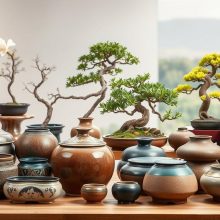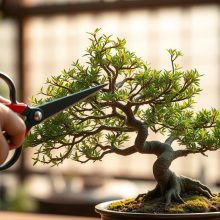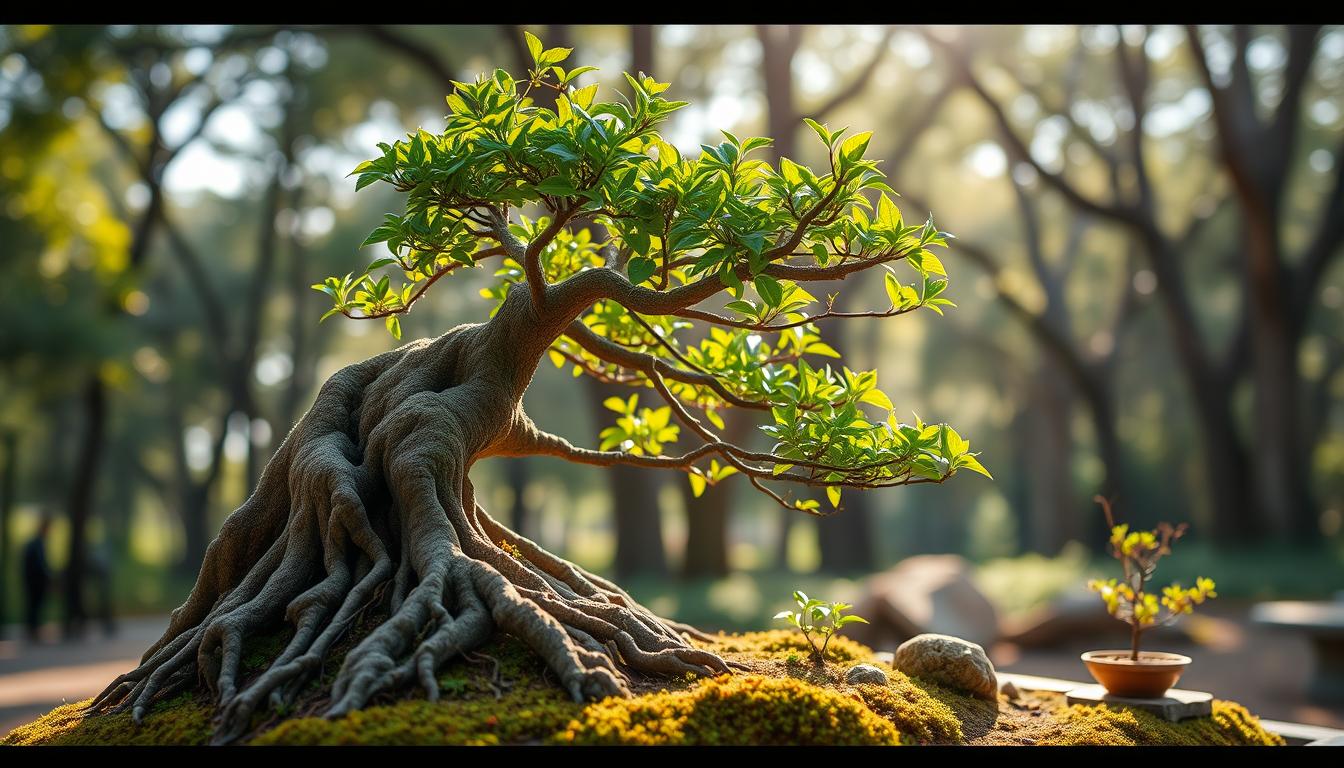Essential Bonsai Styling Techniques for Beginners
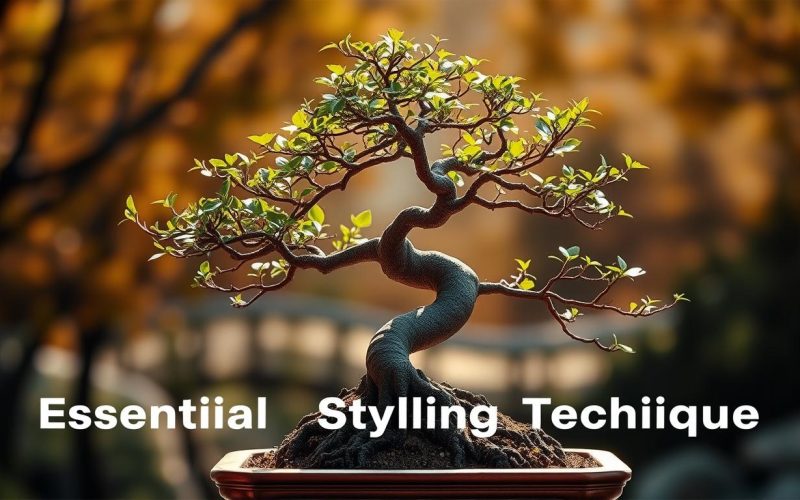
Bonsai styling is a delicate art that turns regular trees into living masterpieces. It lets enthusiasts create tiny landscapes that show the beauty of nature in a small way. This art form mixes gardening skills with a creative eye.
Experts in bonsai use careful pruning to shape and control trees. They use everything from simple cuts to detailed changes to shape the tree. Beginners can learn to shape trees while keeping them healthy and looking good.
Learning bonsai styling means mastering many techniques to make stunning small trees. Practitioners get to know how plants grow, helping them shape trees into amazing forms. These forms show both creativity and a deep understanding of plants.
Key Takeaways
- Bonsai styling combines artistic vision with horticultural expertise
- Precise pruning techniques are crucial for tree development
- Understanding plant growth patterns helps create beautiful designs
- Patience and practice are essential for successful bonsai shaping
- Techniques can transform ordinary trees into living art forms
Understanding Bonsai: A Brief History
Bonsai is a unique art form that mixes gardening with art. It has ancient roots and shows the beauty of nature in small spaces. Through bonsai, artists turn simple plants into works of art that share stories of patience and creativity.
The history of bonsai starts in ancient China during the Tang Dynasty. It was there that landscape cultivation began. Japanese monks later took these techniques and made them into a fine art. They created small versions of natural landscapes.
The Art of Bonsai
Bonsai is more than gardening; it’s a way to connect with nature. It requires understanding plants and beauty. The art involves several key elements:
- Careful pruning to control tree shape
- Strategic wiring of branches
- Selecting appropriate container sizes
- Understanding plant physiology
Cultural Significance
In Asian cultures, bonsai stands for harmony, balance, and respect for nature. These small trees symbolize patience, discipline, and the bond between humans and nature.
Different Styles of Bonsai
Bonsai has evolved into many styles, each with its own look. Some famous styles include:
- Formal Upright Style
- Informal Upright Style
- Slanting Style
- Cascade Style
- Semi-Cascade Style
Each style has its own beauty and needs special skills. Artists learn these through years of practice.
Choosing the Right Tree Species for Bonsai
Finding the perfect tree species is key to mastering bonsai styling. Each tree has its own special traits that can make your bonsai stand out. The right tree depends on several factors like growth, looks, and success.
For beginners, it’s best to start with trees that are easy to work with. Knowing each tree’s needs and how it grows is important for success.
Popular Species for Beginners
- Juniper: Highly resilient and perfect for bonsai trunk bending
- Japanese Maple: Beautiful leaf structure and color variations
- Ficus: Tolerant of indoor conditions and quick-growing
- Chinese Elm: Versatile and responsive to pruning techniques
Factors to Consider
When picking a bonsai tree, think about these important things:
- Climate compatibility with your local environment
- Growth rate and potential size
- Leaf size and texture
- Branching characteristics
Seasonal Adaptations
Every tree species reacts differently to the seasons. Knowing how your tree adapts is key to keeping it healthy. Some trees need protection in winter, while others do best in certain temperatures. Learning about your tree’s natural habitat helps create the best growing conditions.
Basic Tools Needed for Bonsai Styling
Bonsai styling needs specific tools for shaping and keeping miniature trees. Professional bonsai artists know the right tools are key for growing and shaping trees. They are also important for artistic expression.
Learning bonsai wiring and pruning requires a set of specialized tools. Beginners should get quality tools to support their journey and tree growth.
Essential Tools for Bonsai Styling
- Bonsai Pruning Shears: Precision cutting for branches and roots
- Concave Cutters: Creates clean, flush cuts with minimal scarring
- Wire Cutters: Specialized for removing bonsai wiring without damaging branches
- Small Paintbrush: Cleaning delicate areas and removing debris
- Aluminum and Copper Wiring: For shaping tree branches and trunk
Tool Maintenance Best Practices
- Clean tools after each use with rubbing alcohol
- Keep cutting edges sharp for precise bonsai styling techniques
- Store tools in a dry, protective case
- Regularly oil moving parts to prevent rust
- Sharpen cutting edges periodically
Investing in quality tools and keeping them in good shape will improve your bonsai skills. It will also help you succeed in this detailed art form.
Initial Tree Preparation Techniques
Bonsai styling needs careful preparation and a strategic plan. The first steps in preparing a tree are key to a stunning miniature landscape. Learning the basics of wiring and pruning is essential for growing a successful bonsai.
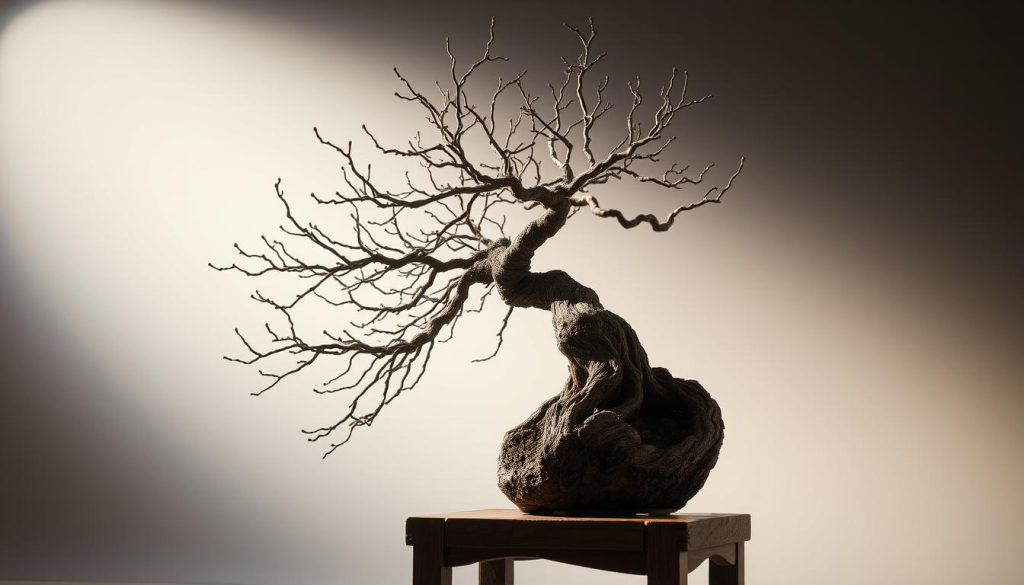
Wiring Basics for Bonsai Branch Selection
Wiring is a crucial skill in bonsai styling. It lets artists shape and train tree branches. Here are important tips for choosing branches to wire:
- Choose branches with flexible wood
- Select branches that contribute to the overall design
- Avoid wiring branches thicker than pencil width
- Ensure proper wire angle and tension
Pruning Fundamentals
Pruning is vital in bonsai branch selection. It helps shape the tree and promotes healthy growth. Beginners should remove:
- Dead or damaged branches
- Branches crossing or rubbing against each other
- Branches that disrupt the tree’s visual balance
- Excess growth that detracts from the intended design
Learning these initial techniques is crucial. It helps bonsai enthusiasts create beautiful, well-structured trees. These trees show artistic vision and a deep understanding of botany.
Bonsai Styling Techniques: An Overview
Bonsai styling turns regular trees into tiny art pieces. It lets gardeners make small landscapes that show nature’s beauty in a small way. Knowing how to shape bonsai trees helps people make unique and beautiful trees.
Bonsai artists use key techniques to make stunning small trees. Each style shows how trees grow in different natural settings.
Formal Upright Style
The formal upright style looks like trees growing in open spaces with lots of sunlight. It has:
- Straight, vertical trunk
- Symmetrical branch distribution
- Tapering trunk from bottom to top
- Ideal for coniferous species like pine and spruce
Informal Upright Style
The informal upright style is for trees growing in changing environments. It has:
- Slightly curved or zigzag trunk
- Asymmetrical branch placement
- More natural, organic appearance
- Suitable for deciduous trees like maples
Slanting Style
The slanting style shows trees growing on hillsides or facing strong winds. It involves:
- Trunk angled at 60-80 degree angle
- Root system supporting the leaning trunk
- Branches positioned to balance the tree’s inclination
- Reflects trees adapting to environmental challenges
Each bonsai style needs patience, practice, and knowing how trees grow. Mastering these styles lets gardeners make amazing small landscapes that share unique stories.
Wiring Techniques for Bonsai
Bonsai styling needs a lot of detail, with bonsai wiring being key. Wiring helps shape and train trees. It lets artists create beautiful forms that look like mature trees in nature.
Learning bonsai wiring can turn a simple plant into a stunning miniature landscape. It’s all about picking the right wire and using it with care.
Selecting the Right Wire
Choosing the right wire is vital for bonsai styling. There are different wires for different needs:
- Aluminum wire: Ideal for deciduous trees
- Copper wire: Best for hardwood species
- Thickness ranges from 1mm to 4mm
Proper Wiring Techniques
Getting good at bonsai wiring takes time and patience. Here are some important tips:
- Wrap wire at a 45-degree angle
- Maintain consistent tension
- Avoid damaging bark
- Work carefully around delicate branches
Techniques for Removing Wire
When to remove wire is very important to avoid scarring. Use special bonsai tools to cut wire, starting from the branch end. Remove wire before it hurts the bark, usually after a few months.
Pruning Styles and Approaches
Bonsai styling needs precise pruning to shape and keep the tree healthy. Knowing different pruning methods helps turn regular plants into art.
Pruning is key in bonsai care. It involves removing parts of the tree to control its growth and look. It’s more than just trimming; it’s a way to sculpt the tree’s shape and health.
Structural Pruning Fundamentals
Structural pruning is a bold bonsai technique. It focuses on the tree’s main form and design. Important steps include:
- Removing major branches to define the tree’s basic silhouette
- Creating balanced branch distribution
- Eliminating crossing or competing branches
- Establishing the desired tree shape
Maintenance Pruning Strategies
After setting the structure, maintenance pruning keeps the bonsai’s shape and promotes growth. This involves:
- Regular trimming of new shoots
- Controlling branch length
- Maintaining the tree’s intended design
- Promoting dense foliage development
Advanced Leaf Pruning Techniques
Leaf pruning refines the tree’s look by choosing which leaves to remove. It improves the tree’s details, reduces leaf size, and boosts its beauty.
Learning these pruning methods takes time, patience, and understanding plant growth. Each cut must be thoughtful and aimed at enhancing the tree’s artistry.
Creating Depth and Perspective in Bonsai
Bonsai styling is more than just shaping trees. It’s about creating depth and perspective that looks like real landscapes. Bonsai artists use special techniques to turn small trees into art that tells stories.
Learning to bend bonsai trunks is key to making three-dimensional art. This skill lets artists create shapes that pull the viewer’s eye through the miniature world.
Layering Techniques
Layering is about placing branches to show depth and complexity:
- Use different branch lengths and angles
- Make gaps between foliage sections
- Set up a clear foreground and background
- Use varying branch density
Use of Rocks and Wood
Adding natural elements makes bonsai more interesting:
- Choose stones and driftwood that match
- Place them to look like real terrain
- Balance the tree with the materials
- Use rocks to look like landscape features
These advanced bonsai techniques turn small trees into amazing three-dimensional scenes. They show the beauty of natural growth and how trees interact with their environment.
Enhancing Root Visibility
Bonsai styling is all about working with the tree’s roots. It’s key to the tree’s look and health. Knowing how to prune bonsai roots is crucial for creating beautiful mini worlds.
Managing roots is an art that needs precision and care. Bonsai lovers must learn special skills. These skills help keep the tree small and healthy.
Root Pruning Techniques
- Remove damaged or overgrown roots during early spring
- Use clean, sharp pruning tools to minimize tree stress
- Cut roots at a 45-degree angle to encourage new growth
- Leave sufficient root mass to support the tree’s health
Pruning bonsai roots right means knowing what the tree needs. Each tree reacts differently to root care. So, watching the tree closely is key to keeping it alive.
Exposing the Nebari
The nebari is the part of the roots you see. It’s the base of your bonsai’s look. Showing off these roots takes careful pruning and patience.
- Carefully trim surface roots to create balanced exposure
- Gently spread roots during repotting to enhance natural spread
- Use specialized techniques to encourage horizontal root growth
- Protect exposed roots from direct sunlight and extreme conditions
Getting good at bonsai root care takes a lot of practice. Every change makes the tree more unique and beautiful.
Seasonal Styling Considerations
Mastering bonsai styling is all about knowing how seasons affect tree care. Each season brings its own set of challenges and chances for bonsai lovers to shape their trees.
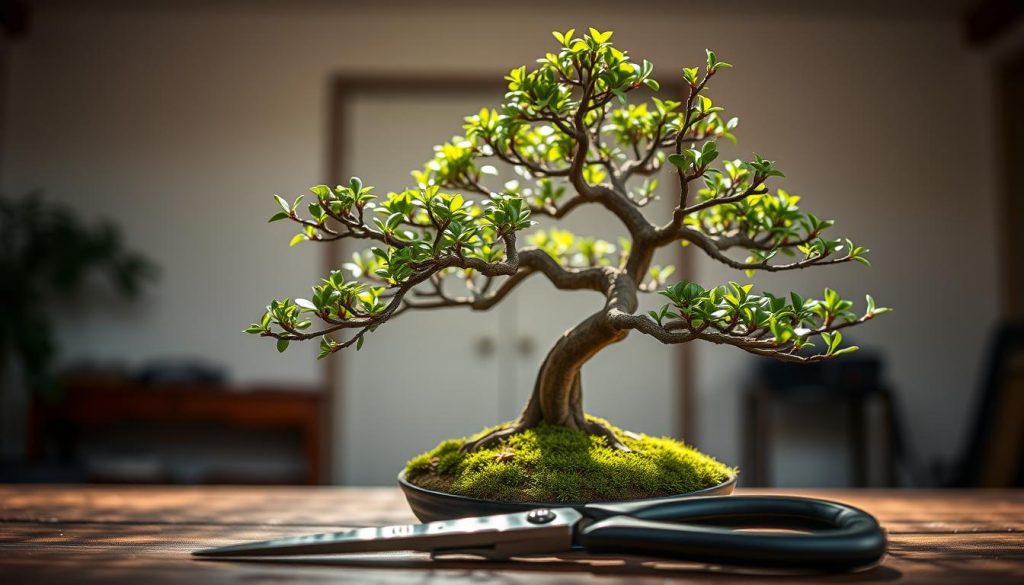
Knowing your tree’s needs by season is key to successful styling. Pruning, wiring, and care change with the seasons.
Best Times for Styling Techniques
- Spring: Ideal for bonsai repotting and initial shaping
- Late winter: Perfect for structural pruning before new growth
- Summer: Focus on maintaining tree health and light pruning
- Fall: Prepare trees for winter dormancy
Seasonal Changes in Care
Bonsai care must change with the seasons. Spring is the best time for styling and repotting. Trees are most active, ready for shaping and root work.
- Spring: Maximum growth and styling potential
- Summer: Protect from extreme heat and maintain hydration
- Autumn: Reduce fertilization and prepare for winter
- Winter: Minimal intervention, focus on protection
Grasping these seasonal changes will help bonsai fans grow stronger, more beautiful trees all year.
Common Mistakes in Bonsai Styling
Learning bonsai styling takes time, skill, and knowing what to avoid. Beginners often make mistakes that harm their bonsai trees. It’s key to know these errors to shape bonsai trees well.
Bonsai is all about detail and respecting the tree’s natural growth. Common mistakes can hurt the tree’s health and look. It’s important to avoid these to keep your bonsai looking good.
The Dangers of Over Pruning
Over pruning is a big mistake in bonsai. It can:
- Weaken the tree’s structure
- Change its natural growth
- Make it hard for the tree to make food
- Harm the tree’s health over time
Incorrect Wiring Techniques
Wiring bonsai wrong can cause big problems. Beginners often make these mistakes:
- Wire too tight, hurting bark and branches
- Leave wire on too long
- Use the wrong wire size for the tree
- Not check wire tightness as the tree grows
Experts say to watch closely and handle gently. Knowing these mistakes helps you avoid harming your bonsai tree.
Resources for Continued Learning
Mastering bonsai styling takes dedication and ongoing learning. Whether you’re new or have some experience, learning more can boost your skills.
The bonsai world is full of chances to grow and get better. You can find many ways to learn more about bonsai defoliation and advanced techniques.
Recommended Books and Learning Materials
- Classic texts by famous bonsai masters
- Comprehensive guides on bonsai styling
- Books about specific tree species
- Digital publications and e-books for easy learning
Online Courses and Digital Resources
- Professional video tutorials on bonsai care
- Interactive online workshops
- Webinars by expert bonsai practitioners
- Virtual training platforms for bonsai techniques
Bonsai Clubs and Community Engagement
Joining bonsai clubs, local or international, is very helpful. These groups offer direct access to experts, hands-on workshops, and a chance to meet others who love bonsai.
- Local bonsai clubs in your area
- National bonsai associations
- International bonsai forums and groups
- Social media communities for bonsai styling
Keep learning and practicing to get better at bonsai styling. Use these resources to improve your skills and make your bonsai journey more rewarding.
Conclusion: Mastering Bonsai Styling Techniques
Bonsai styling is a deep art that mixes plant knowledge with creativity. It takes dedication, patience, and a good grasp of plant biology. Choosing the right branches is key to turning ordinary plants into stunning works of art.
Getting better at bonsai takes lots of practice and watching others. Beginners should see each time they prune or wire as a chance to learn and grow. The beauty of bonsai comes from both skill and the artist’s unique vision.
As you get better, remember that each tree has its own story. Your style will show through careful study, trying new things, and respecting each plant’s natural growth. Don’t be afraid of mistakes, learn from others, and let your creativity lead your bonsai design.
Bonsai is a lifelong journey of finding balance between helping the tree grow and letting it be natural. With steady practice and an open mind, you can make simple plants into amazing mini worlds that show your art and connection to nature.
